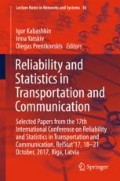Abstract
In this paper, we propose a model of the bus lines synchronisation based on simulation of the public transport system with a genetic algorithm as a tool to obtain some rational solution. The proposed approach considers stochastic nature of the public transport technological processes and provides in a short time a solution close to optimal. The total waiting time for passengers at all the nodes of a public transport network is used as the objective function in the synchronisation problem. Synchronisation is implemented due to time shifts at the schedules for public transport line; these time shifts are represented as chromosomes of a genetic algorithm. In order to evaluate the objective function, simulations of a public transport network were provided. The developed mathematical model is implemented in Python within the frame of a class library for modelling of public transport processes. A case of a public transport system of Bochnia city is applied to illustrate the procedure of synchronisation on the grounds of the developed model.
Access this chapter
Tax calculation will be finalised at checkout
Purchases are for personal use only
References
Bruno, G., Improta, G., Sgalambro, A.: Models for the schedule optimisation problem at a public transit terminal. OR Spectr. 31(3), 465–481 (2009)
Shrivastava, P., Dhingra, S.L.: Development of coordinated schedules using genetic algorithms. J. Transp. Eng. 128(1), 89–96 (2002)
Wu, Y., Yang, H., Tang, J., Yu, Y.: Multi-objective re-synchronizing of bus timetable: model, complexity and solution. Transp. Res. Part C 67, 149–168 (2016)
Ceder, A., Golang, B., Tal, O.: Creating bus timetables with maximal synchronisation. Transp. Res. Part A 35(10), 913–928 (2001)
Wihartiko, F.D., Buono, A., Silalahi, B.P.: Integer programming model for optimizing bus timetable using genetic algorithm. IOP Conf. Ser.: Mater. Sci. Eng. 166, 012016 (2017)
Liu, T., Ceder, A.: Synchronisation of public transport timetabling with multiple vehicle types. Transp. Res. Rec. 2539, 84–93 (2016)
Ibarra-Rojas, O.J., López-Irarragorri, F., Rios-Solis, Y.A.: Multiperiod bus timetabling. Transp. Sci. 50(3), 805–822 (2016)
Shen, Y., Wang, S.: An adaptive differential evolution approach for the maximal synchronisation problem of feeder buses to metro. J. Comput. Theor. Nanosci. 13(6), 3548–3555 (2016)
Teodorović, D., Lučić, P.: Schedule synchronisation in public transit using the fuzzy ant system. Transp. Planning Technol. 28(1), 47–76 (2005)
Wu, W., Liu, R., Jin, W.: Designing robust schedule coordination scheme for transit networks with safety control margins. Transp. Res. Part B 93A, 495–519 (2016)
Bookbinder, J.H., Désilets, A.: Transfer optimisation in a transit network. Transp. Sci. 26(2), 106–118 (1992)
Dou, X., Yan, Y., Guo, X., Gong, X.: Time control point strategy coupled with transfer coordination in bus schedule design. J. Adv. Transp. 50(7), 1336–1351 (2016)
Lee, M., Schonfeld, P.: Optimal slack time for timed transferred at transit terminal. J. Adv. Transp. 25(3), 281–308 (1991)
Ting, C., Schonfeld, P.: Schedule coordination in a multiple hub transit network. J. Urban Planning Dev. 131(2), 112–124 (2005)
Nesheli, M., Ceder, A., Gonzalez, V.: Real-time public-transport operational tactics using synchronized transfers to eliminate vehicle bunching. IEEE Trans. Intell. Transp. Syst. 17(11), 3220–3229 (2016)
Naumov, V., Samchuk, G.: Class library for simulations of passenger transfer nodes as elements of the public transport system. Procedia Eng. 187, 77–81 (2017)
Class library for modeling a public transport network. https://github.com/naumovvs/publictransportnet. Accessed 15 July 2017
Author information
Authors and Affiliations
Corresponding author
Editor information
Editors and Affiliations
Rights and permissions
Copyright information
© 2018 Springer International Publishing AG
About this paper
Cite this paper
Naumov, V. (2018). Synchronisation of Timetables for Public Bus Lines Using Genetic Algorithms and Computer Simulations. In: Kabashkin, I., Yatskiv, I., Prentkovskis, O. (eds) Reliability and Statistics in Transportation and Communication. RelStat 2017. Lecture Notes in Networks and Systems, vol 36. Springer, Cham. https://doi.org/10.1007/978-3-319-74454-4_4
Download citation
DOI: https://doi.org/10.1007/978-3-319-74454-4_4
Published:
Publisher Name: Springer, Cham
Print ISBN: 978-3-319-74453-7
Online ISBN: 978-3-319-74454-4
eBook Packages: EngineeringEngineering (R0)

